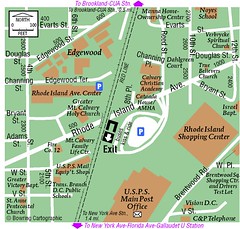Rhode Island Metro Area -- Student Design Studio Presentation this Saturday
From Deborah Crain, Neighborhood Planner, Ward 5 --
We Want To Hear From You:
About the Rhode Island Avenue Metro Station Area
 Rhode Island Station entrance area gets a grade of "N"--"Needs to Improve"
Rhode Island Station entrance area gets a grade of "N"--"Needs to Improve"Meeting Purpose: The Rhode Island Avenue Metro Station vicinity is experiencing new development and change. See that the change reflects the needs of your neighborhood. Through lively small group discussions, voice your opinion on…
· Stores you would like to see in your community
· Sidewalks/streets that need to better accommodate pedestrians
When: Saturday April 2; 9:30 am - 12:00 noon
Where: The Washington Center for Aging Services, 2601 18th Street NE, Washington, DC
Sponsored By: The University of Maryland Urban Studies and Planning Program, with support from your local Advisory Neighborhood Commissioners and the DC Office of Planning. For more information or to RVSP, please call 301-405-6793 or email us at umdurbanstudies@yahoo.com
 Area around the station. Both images from www.stationmasters.com
Area around the station. Both images from www.stationmasters.com___________
This presentation is by an architecture-urban planning studio class at the University of Maryland. I find that these student design studios often do some great work and sometimes they are less constrained politically than designer-planners working under a government agency RFP. (OTOH they are students, and they are likely to be less skeptical about what they are told, how the problem is defined to them by the "government" etc.)
The challenge is to figure out how to have such work get into the issue and policy space, get such work into the hands of the community, and to help keep such plans "top of mind", rather than as the old saying goes "the plan just goes up on the shelf along with the rest of the shelf-full of plans that have been done already."
One way to help this is via the web. For example, the East Carson Main Street program has their neighborhood plan on their website (although it takes a couple clicks, including an obscure choice to get there). This neighborhood site from Greensboro has links to their neighborhood plan and historic district design guidelines right on the front page of the site. (I have direct links to the H Street Strategic Development Plan and the H Street Transportation-Streetscape Study in the neighborhood links section on this website.)
Both the Office of Planning and DC's Department of Transportation put all their new plans on the web, with DDOT choose either Transportation Plans or Studies and with OP click on Neighborhood and Revitalization Plans. DDOT's landing page is an alphabetical list, while OP asks you to access plans by Ward. Therefore, it only takes two clicks to get to what you want for DDOT, while it can take as many as 9 clicks for you to get access to all the OP plans.
The other challenge is also to build the capacity of local groups, ANC Commissioners and the planning-zoning committees of each ANC, etc., so that citizens can utilize such plans and advocate for excellence in design to help maintain and extend livability and beauty in the city. The entry from last Thursday on Neighborhood Planning discusses some of my thoughts on this.



0 Comments:
Post a Comment
<< Home